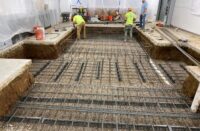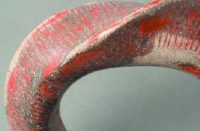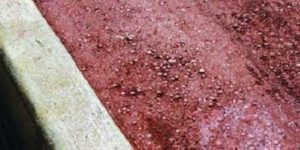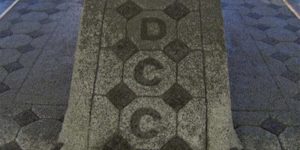
Although the use of pervious concrete is certainly on the rise, you won’t often hear the words decorative and pervious coupled together.
Pervious concrete is a specialized pavement mix that allows water and air to easily pass through a maze of interconnected voids. An important player in the growing sustainable construction movement, it’s frequently described as looking like Rice Krispies. Pervious concrete typically consists of portland cement, 3/8-inch coarse aggregate and water, with admixtures sometimes added to improve placeability.

“People who want to use it are looking for utility and they don’t want to pay for the decorative finish,” says Sergio Ilic, owner of Heritage Bomanite in Fresno, observing that the basic mix is more expensive than traditional concrete.
But if you look at the big picture, the cost of paving with pervious may be more economical than at first glance. Certain systems can reduce the need for retention basins and storm-water drainage systems in large projects, making for more effective land use.

Pervious systems also can help filter out pollutants, replenish local aquifers and improve root systems’ access to air and water, making for healthier, longer-living trees.
Safety-wise, pervious keeps water from pooling, eliminating standing puddles and reducing the probability of black ice in winter. In the area of climate control, it helps alleviate the urban heat island effect since it absorbs less heat in the day and releases less heat at night than conventional pavements.
With all these pluses, contractors may be able to persuade clients that a pervious job can look pretty, too, with a little extra investment.

“Although the main purposes of the product are storm-water mitigation, groundwater recharge or new-water harvesting, it doesn’t have to look like an all-natural, organic aggregate surface,” says Guy Collignon, president of Enviro-Crete Inc. in Sacramento. “Gray concrete in any form is fine with me, but color improves the flavor to the eye for very little effort.
The trickle-down effect
Pervious concrete was first used in this country in the early 1980s, mainly in Florida, but it’s been used in Europe for about 150 years, says Dan Huffman, vice president of national resources for the National Ready Mixed Concrete Association. “People weren’t using it to achieve porosity or permeability like what it’s used for today. Sand was frequently in short supply, so they made concrete without sand.”
In the United States, Huffman says, pervious concrete is largely used for parking areas, but it’s increasingly showing up in sidewalks, driveways, patios, alleys, parks, plazas and public access areas. And it’s not just being used in the Southeast. It’s starting to penetrate the West Coast and Upper Midwest and otherwise become known nationally.
“We’re seeing pervious use rapidly rise in response to increasing environmental needs where stricter storm-water regulations are being enforced or greatly stimulated,” Huffman says. In fact, the Environmental Protection Agency has listed the appropriate use of pervious concrete among its recommended best management practices for compliance with federal storm-water regulations, and some states and localities are rapidly following suit.
Coloring and cutting
So you’ve decided to install pervious concrete, and you want to incorporate some kind of decorative element. What are your options?
“The best way to color pervious from a durability standpoint is to use integral color. That’s my first choice,” says Mike Riggs, president of Progressive Concrete Works in Phoenix. He’s used integral color in several parking lots he’s paved. He says he’s also had success with ConColor, a spray-applied lithium-based stain from Bomanite that mimics the look of acid stain.
“I’d never try to acid-stain pervious concrete,” he says, noting that all that heavy metal would just flow through the permeable surface to the ground below. “And color hardener is out of the question. It would be impossible to work in since pervious is too dry.”
While he shies away from stamping pervious concrete because he’s not sure the imprints would meet the standards of the Americans with Disabilities Act, he saw-cut and colored a star pattern about two years ago in the driveway of his company’s parking area. “The cuts are about a quarter inch deep,” he says. “The high points of the aggregate have worn off, but there’s enough open void in the pattern that there will never be enough traffic to completely wear it away.”

To try to drum up some pervious decorative business in Fresno, Ilic converted 6,000 square feet of his parking lot to pervious concrete in 2005, and has been converting the rest bit by bit, although he has yet to land a decorative pervious commercial job. “We tried rubber stamps and they don’t work very well,” he says, adding he couldn’t produce an acceptable texture on top of pervious because the surface is so open. But the old Bomanite metal stamps, he says, work well for creating patterns.
If you are going to stamp a pattern into pervious concrete, it works best to stamp through plastic curing film, says Dave Mitchell, founder of Bunyan Industries, a Salt Lake City company known for its screed system.
Craig Morrison, a former homebuilder and residential developer who founded Pervious Concrete Inc. in Snohomish, Wash., has been using pervious for about six years. He says he helped pioneer use of the product in the Pacific Northwest when he used it in one of his residential developments that had a storm-water management issue. Going that route allowed him to eliminate the need for storm-water retention vaults, underground pipes, curbs and catch basins. He gained two extra lots and turned a profit.
At a house overlooking the Puget Sound, Morrison sprayed part of a surrounding pervious walkway a deep blue and incorporated different-sized rocks, metal salmon and other creatures along the concrete “waterway,” which emptied into a “lake” on the pervious patio.
He’s also done a fair share of residential driveways. “That’s probably the simplest way to combine pervious and decorative,” he says. “You just need to choose a color that complements the house and a stone that’s coarse enough to match the house’s texture.”
As for sealers, Riggs says, they’ll work as long as you have a good open mix that drains well. “It’s important you only apply a light coat and use a sealer that breathes and can handle vapor transmission.”
Freeze-thaw no longer a problem Thanks to advances in design and construction and better mixes of raw materials, pervious concrete can be as durable as other paving materials even in areas with harsh winters, which caused problems for pervious in its earlier years.
“If the concrete is made, installed, cured and maintained correctly, you shouldn’t have any problem with freeze-thaw issues as long as the water has someplace to go,” says John Lee, P.E., sales manager for civil and engineered sales for Cemstone, a Minnesota-based company that owns and operates a network of ready-mix concrete plants and aggregate facilities.
“The key to making pervious concrete work is to use aggregate particles that aren’t susceptible to freeze-thaw,” Lee says. “You need really hard stones whose absorption qualities are not too high and not too low. Stay away from shale, chert, iron oxide and anything that a producer would call a poor aggregate. Certain granites and trap rock will work well.”
The LEED-accredited salesman says Cemstone has been making its pervious mix from “falkstone,” a crushed dolomitic limestone with really low absorption, for about five years now. He cites the Woodbridge neighborhood in Shoreview, Minn., which had all its roads replaced with pervious this past summer to solve storm-water and infiltration issues, and Edgewater Park, a 2.5-acre park in Minneapolis designed to handle storm-water runoff, as evidence the product will last.
Edgewater Park, built in fall 2006, features integrally colored, primarily pervious sidewalks intermingled with concrete pavers. Ramsey, Minn.-based North County Concrete applied water-based stain on the sidewalks to create a design that mimics the paths of the nearby Mississippi and Minnesota rivers. Reportedly, the contractor used a lot of stain, as it tends to run right through pervious’ porous surface.

Pervious at the Olympics
One of the most eye-catching decorative pervious jobs undertaken to date involved the staging grounds for the 2008 Olympic Games in Beijing, China. “We supplied a lot of the machinery used on the 2.7 million square feet of pervious concrete placed for Olympic facilities,” says Mitchell. “That job took about a year and a half, with 500 men living on-site, 24/7.”

To maintain the job’s cost-effectiveness while still delivering dazzling colors, the Chinese opted to place the pervious concrete in two layers. The lower layer, or structural course, was made with large aggregate, low cement and no admixtures, while the top layer was premium aggregate selected for its color and gradation with a carefully blended proportion of integrally colored cement. “The lower layer is harsh and cheap while the top layer is sweet and expensive,” Mitchell says.
Typically, the layers were placed 20 feet wide by 1,000 feet or more in length. Usually, pervious concrete is at least 6 inches deep. At the staging ground, the two layers combined were about 9 inches deep.
“The first layer is pounded into place, and you have to make sure that water still percolates through the pavement. To assure a proper bond between layers, the second placement must proceed within 20 minutes of completion of the first,” he says.
Although this two-layer method is cheaper than using a premium mix throughout the full thickness, there’s still considerable expense with two placements, Mitchell says. However, he says, “you don’t have to be nearly as careful with the structural course.” This method, he adds, is a highly unusual way to place pervious.
Tiger striping and other issues
Working with pervious concrete poses several challenges. “It looks easy to install but it’s not forgiving at all,” Riggs says. “You don’t want to overwork the material.”
“Some contractors stamp pervious, but you have to be quick,” Collignon says, because it sets up in about 20 minutes.
“Pervious is all about how you manage the water – from the batch water, the added water and the evaporating water, continuing through the moist-cure phase of construction,” Mitchell says. “Those things will give you a headache if not addressed properly, especially in dry and freezing climates.”
Pervious concrete requires a moist-curing period of a full seven days after placement, or the structure of the slab will be at serious risk. However, protective film laid to control the cure causes its own problem where it wrinkles – mottled color variations that some call tiger or zebra striping.

“This discoloration was prevented on the Chinese pavement by shifting the wrinkles in the poly sheeting daily,” Mitchell says. They also remoistened the concrete to assure maximum hydration.
Lee with Cemstone recommends using UltraCure, a product made by McTech Group. “It’s basically like a diaper,” he says. “You presoak it and lay it on the concrete to get a wet cure for days.” Disposable and lightweight, it’s touted as a great help in reducing discoloration.
Riggs says the zebra striping lines are typical with pervious concrete and he lets clients know to expect them. “To mitigate the problem if we’re using an integral color, we go back over these lines with a real light application of Davis color seal or wax.” He says he’s also heard of people using bean oil with good results.
Curing is really important, Riggs reiterates, and so is having the proper mix. “If you don’t pay attention to all the details, you’ll have failure like surface raveling,” where the surface aggregate loosens and breaks free – an age-old problem associated with pervious. “You should try different mix designs before you start a project.”
And before you start, be sure you have a well-thought-out plan.
“There’s been a lot of trouble resulting from problems associated with hydration,” Mitchell says. “This clearly becomes our main consideration as we proportion the mix design of pervious concrete as well as (deal with) the special handling and testing that’s entirely different from conventional concrete.
“We have had good success with decorative contractors as they build pervious pavement,” he notes. “They seem to be more attentive to details and timing. The winners and losers in pervious are based on how they manage the water. Decorative guys are generally a more careful lot, unlike those who are geared to higher volume.”
www.azcement.com
www.bunyanusa.com
www.cemex.com
www.cemstone.com
www.mctechgroup.com
www.nrmca.org
Serious about Pervious? Get Certified
To help promote successful pervious projects, the National Ready Mixed Concrete Association began its Pervious Concrete Contractor Certification Program in 2006. It’s designed to be administered by local sponsoring groups across the country in conjunction with planned training sessions or demonstrations.
There are three levels of certification:
Pervious Concrete Technician is awarded to people who have passed a written exam to prove they know how to place, compact, finish, edge, joint, cure and protect pervious concrete.
Pervious Concrete Installers have passed the same test and have also demonstrated their ability to perform the proper techniques on a minimum of three projects that encompass at least 10,000 square feet of pervious pavement.
Pervious Concrete Craftsman is awarded to people who have passed the initial test and have at least 3,000 hours of field experience in all aspects of placing pervious concrete.
To date, there are 5,668 NRMCA-certified technicians, 40 installers and 17 craftsmen.
“Installation of pervious concrete is very different than conventional, so it requires special training,” says Michael Kohout, P.E., Western regional concrete engineer for Cemex USA, a concrete supplier in the Phoenix area. And the NRMCA program is designed to help contractors learn the ropes.
“I know contractors have a tough time paying for extras, but in the long run, pervious concrete may be beneficial to the bottom line,” says Stew Waller, executive director of the Arizona Cement Association.
Cemex and the ACA, among others, help administer the NRMCA program regionally and offer several classes a year.


















